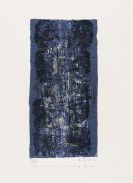
Karl Fred Dahmen
1917 Stolberg bei Aachen
1981 Preinersdorf am Chiemsee
Karl Fred Dahmen attended the Aachen art school from 1931 until it was closed down in 1933. After an apprenticeship as commercial graphic artist, Dahmen became an air raid defence soldier in World War II, in which he was a prisoner of war. In captivity he drew and painted watercolors. After the war the artist returned to Stolberg. He applied to the Düsseldorf art academy and passed their entrance examination only to leave the academy little later to work as an independent artist and founder of the "Neue Aachener Gruppe".
In the post-war era, it was particularly important to Dahmen - and many other German artists - to study the latest artistic trends in Paris. Karl Fred Dahmen wanted to extablish a cultural exchange with the "Ecole de Paris". In 1953 he organized the first German-French exhibition "Heute" at the museum of Aachen with representatives of the "Ecole de Paris".
In 1957 Dahmen joined the "Deutscher Künstlerbund", where he belonged to the group of "Deutsche Tachisten" - his early works reflect these influences. Apart from Tachist-oriented pictures the artist's early work also included wood collages. In 1959 the artist received the first international art prize for abstract painting in Lausanne.
From the mid-1960s he increasingly integrated various objects into his pictures, thus creating material pictures and object cases, with which Dahmen aspired to the same goals as the "Nouveaux Réalistes", i.e. a re-connection of art and life through the use of real objects. In Lausanne Dahmen became a co-founder of the "Nouvelle école européenne". From 1960 to 1967 the artist spent some time on Ibiza every year, where he received a prize for graphic art in 1972. In 1967 he was awarded a professorship at the Munich art academy, which was the reason for his move to the Chiemgau region, where he spent the last years of his life.
As a painter and object artist, Dahmen was one of the earliest and most important exponents of Art informel and was therefore one of the most important artists of post-war Germany.
Related artists: Bissier, Julius Heinrich | Bott, Francis | Brodwolf, Jürgen | Brüning, Peter | Buchheister, Carl | Caspar-Filser, Maria | Cavael, Rolf | Corpora, Antonio | Fautrier, Jean | Gaul, Winfred | Girke, Raimund | Götz, Karl Otto | Hartung, Hans | Hartung, Karl | Hoehme, Gerhard | Imai, Toshimitsu | Jenkins, Paul | Jorn, Asger | Kirkeby, Per | Kricke, Norbert | Mathieu, Georges | Matschinsky-Denninghoff, Martin und Brigitte | Michaux, Henri | Music, Zoran | Nay, Ernst Wilhelm | Nitsch, Hermann | Prachensky, Markus | Rainer, Arnulf | Santomaso, Giuseppe | Schultze, Bernard | Schumacher, Emil | Sonderborg, K.R.H. (d.i. Kurt R. Hoffmann) | Soulages, Pierre | Staudacher, Hans | Stöhrer, Walter | Tàpies, Antoni | Thieler, Fred | Tinguely, Jean | Tobey, Mark | Trier, Hann | Werner, Theodor | Wessel, Wilhelm | Westpfahl, Conrad | Winter, Fritz | Wols, (d.i. Wolfgang Schulze) | Wou-Ki, Zao | Wunderlich, Paul | Zimmer, Bernd

Would you like to sell a work by Karl Fred Dahmen?
Infos for sellerART MARKET:

Etüden. 8 Lithographien
Portfolio, 1959
Estimated price 1.000
More offers >






